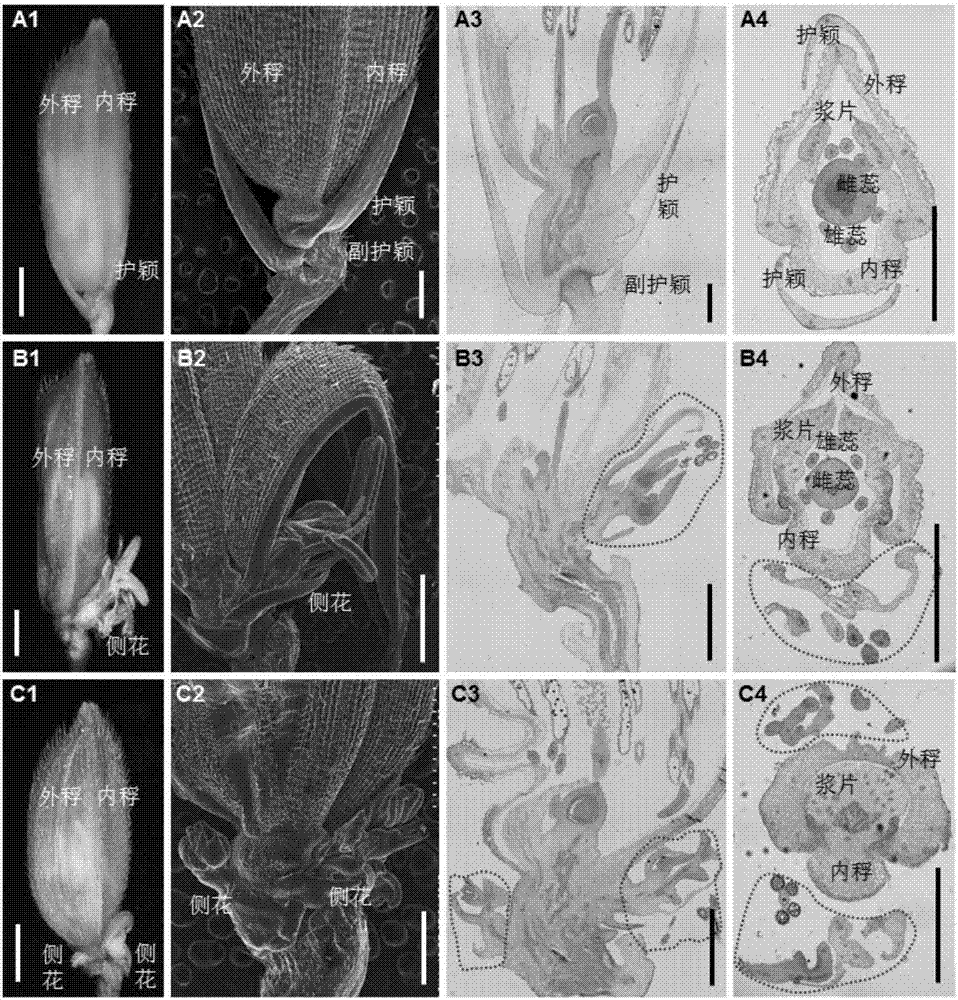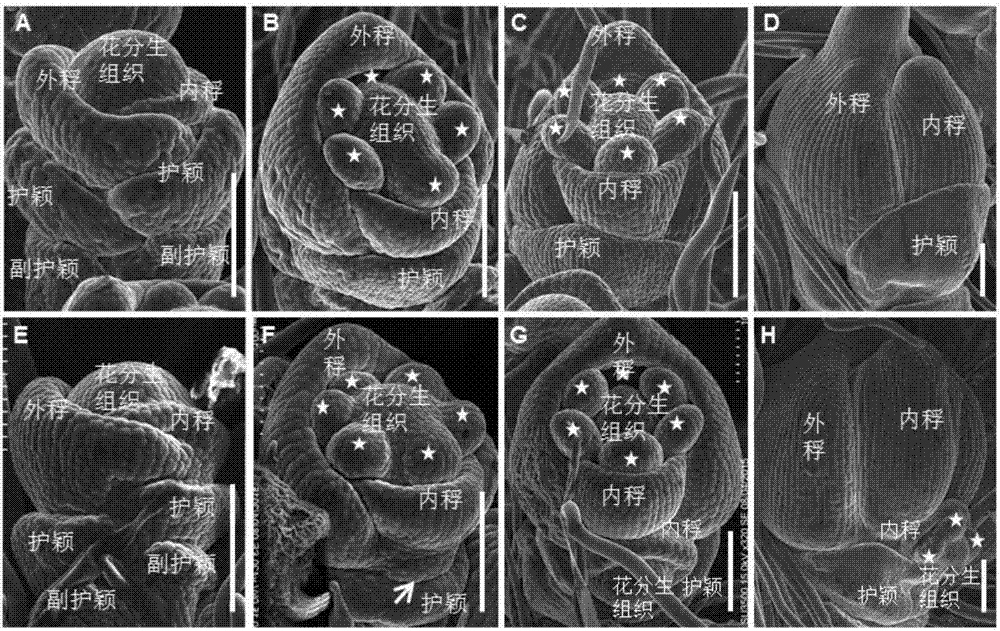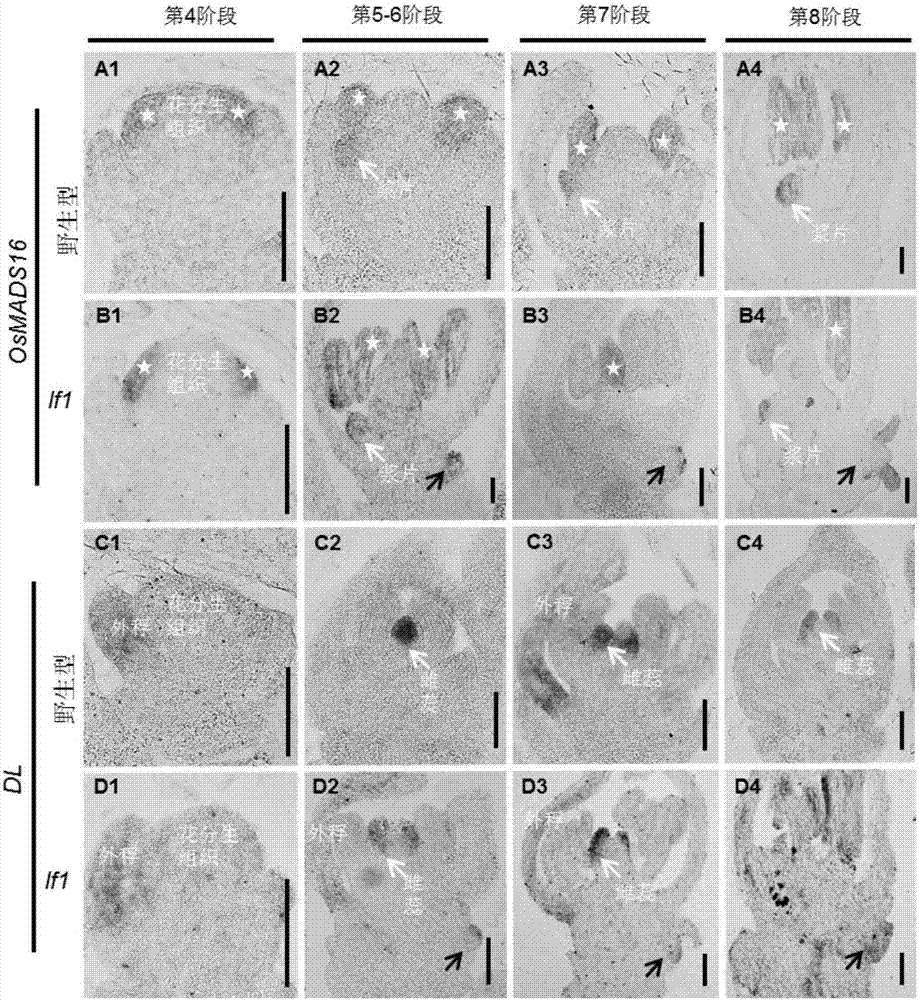Use of rice three-flower spikelet gene LF1 in increase of yield of gramineous food crops
A technology for food crops and rice, applied in the field of molecular biology, can solve the problems of lack of application value, not and other problems, and achieve the effect of improving rice yield and increasing the number of grains per ear
- Summary
- Abstract
- Description
- Claims
- Application Information
AI Technical Summary
Problems solved by technology
Method used
Image
Examples
Embodiment 1
[0046] Example 1 Obtaining and Phenotype Analysis of lf1 Mutant
[0047] Ethyl methanesulfonate (EMS) was used to mutate the self-fertile Jiahui Jinhui 10. In the offspring mutant population, a genetically stable gain-of-function (dominant) mutant of rice -3 flower spikelet was found. Multi-generation self-crossing, genetic stability, named lateral floret 1 (lf1).
[0048] At the heading stage of rice, lf1 and wild-type spikelets were taken for morphological and histological analysis. Morphological analysis: On the one hand, fresh spikelets were observed, dissected and photographed under a Nikon SM1500 stereomicroscope; on the other hand, fresh spikelets were observed under a scanning electron microscope at -40° using a Hitachi SU3500 scanning electron microscope. Histological analysis: fresh spikelets were fixed overnight at 4° in FAA fixative solution (50% ethanol, 0.9M glacial acetic acid and 3.7% formaldehyde), dehydrated through ethanol gradient, xylene replacement, and ...
Embodiment 2
[0053] Example 2 Genetic analysis, gene mapping and map-based cloning of LF1 gene
[0054] The lf1 mutant was crossed with Xida 1A (provided by the Rice Research Institute of Southwest University). A total of 404 F strains with the same phenotype as the lf1 mutant were obtained. 2 Plants were used for genetic analysis and gene mapping of LF1. f 2 The segregation population showed that the segregation ratio between mutant and wild-type plants was 3:1, suggesting that the phenotype of the lf1 mutant was controlled by a pair of dominant nuclear genes.
[0055]Preliminary positioning: BSA (mixed cluster analysis) method was used. Select 480 pairs of SSR primers evenly distributed on the 12 chromosomes of rice Gramene, the Rice Genomic Research Program website, and according to the insertion / deletion fragment difference between Xida 1A and Jinhui 10, SNP (single nucleotide Polymorphisms) self-developed in / del and dCAPs marker primers (ZIn23F / R, ZIn29F / R, ZIn27F / R, Zin67F / R and ...
Embodiment 3
[0061] Example 3 Analysis of the expression pattern of the LF1 gene
[0062] Using real-time quantitative PCR (the sequences of primers qLF1-F and qLF1-R are shown in Table 1, Actin is used as an internal standard, and the sequences of primers Actin-F and Actin-R are shown in Table 1) to detect the presence of LF1 gene in the young panicle and each round flower organ The results showed that LF1 was expressed in young panicles of different periods, especially in young panicles below 2 cm, which were significantly higher than those in other periods. At the heading stage, LF1 was expressed in the glume and the four round flower organs ( Figure 5 a).
[0063] In situ hybridization was used to further analyze the expression pattern of LF1 gene in spikelets (see Table 1 for the sequences of primers LF1-F and LF1SP6-R). At the Sp4 stage, LF1 was abundantly expressed in the terminal florets of wild-type and lf1 mutant spikelets ( Figure 5 b1, b5). From Sp5 to Sp6, LF1 was expres...
PUM
 Login to View More
Login to View More Abstract
Description
Claims
Application Information
 Login to View More
Login to View More - R&D
- Intellectual Property
- Life Sciences
- Materials
- Tech Scout
- Unparalleled Data Quality
- Higher Quality Content
- 60% Fewer Hallucinations
Browse by: Latest US Patents, China's latest patents, Technical Efficacy Thesaurus, Application Domain, Technology Topic, Popular Technical Reports.
© 2025 PatSnap. All rights reserved.Legal|Privacy policy|Modern Slavery Act Transparency Statement|Sitemap|About US| Contact US: help@patsnap.com



